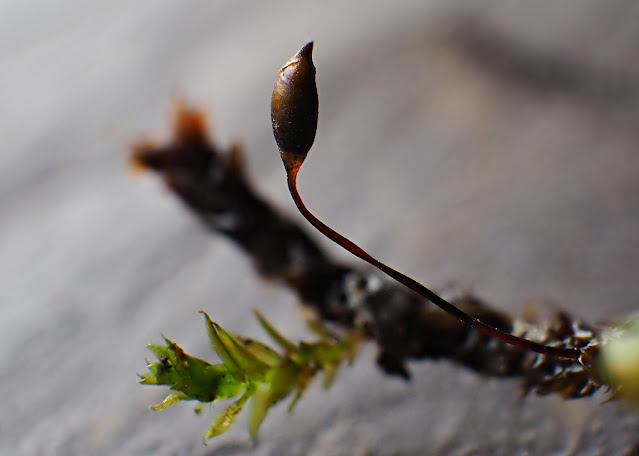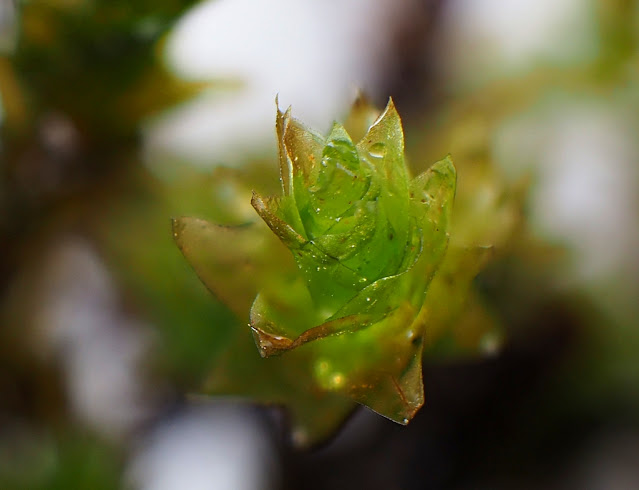Woke up this morning and snow was on the ground and more throwing itself from the sky. That's a change.
In the last week or so light traps have been out on a few occasions, and caught: Acleris hyemana, Acleris heracliana/ciliana (3), Hebrew Character (4), Depressaria radiella (2). Also around and about have been more Depressaria radiella and Brown House Moth in the garage. Best though, and a lifer, Sword-grass in the LEEK lure trap today. This species and this lure have some history apparently.
 |
Tried to make this Acleris heracliana ss but advice sought and has to be A.h. s.l. especially at this time of year.
|
 |
Hebrew Character, common but smart.
|
 |
Male genitalia of the caddis below.
|
 |
Grammataulius nigropunctatus - caddis.
|
The most exciting capture from the light traps, on two consecutive nights was the caddis Grammataulius nigropunctatus, probably out six weeks earlier than it should be.
I've been reading about pheromone trapping, my only experience previously has been using EMP lure for Emperor Moth, it works very well indeed. Over the winter I looked into some lures and sourced some traps. Last week I tried the SKI and FUN lures, not expecting much and not catching anything. I then read that the Leek Moth lure can be good for Common Quaker, well at least I'd be in with a chance. So I ordered some and put a trap out when it arrived. I had low expectations but had a really good outcome with Sword-grass found in the trap yesterday evening after it had been out for two days and a night. A macro moth tick at (just about) first go!
 |
Sword-grass, the white tarsi on the hind leg are a good ID feature. This species has some form coming to this lure I've subsequently been informed, thanks NV.
|
The pitfall traps around the dead hedgehog have continued to produce beetles, Philonthus marginatus, Bisnius puella and Philonthus polita as well as Thanatophilus rugosus. Two of these at least are new, I'm not sure about P. polita, I might have recorded that previously.
 |
Bisnius puella.
|
 |
Philonthus polita (thanks for correcting HS).
|
 |
Philanthus marginatus, an easy Staphy.
|
 |
Thanatophilus rugosus.
|
There's also been Melinopterus sphacelatus in the garden, in one of the other traps, not seen that here very often, although common enough down in the pony fields and at the fields at Birsay Links.
I had a bit of a rummage through the poo at the Links the other day, as you do. Plenty of the above mentioned M.sphac and also good numbers of Aphodius pedellus.
 |
Aphodius pedellus. Not quite sure if this image shows the ID criteria at the tip of the elytra quite clearly enough., field photo, in the poo.
|
Whilst at Birsay Links I was searching for the "other" kelp fly, C. pilipes which I still haven't seen. However, this rather striking Dip was found.
 |
Orygma luctuosum, generally around washed up wood.
|
Elder daughter came home for a rest and managed to find a tick on the dog. I managed to remove it without mangling either the hound or the tick and then tracked down an ID key. It was just the common Ixodes ricina but as I'd never attempted an ID before countable as a new species, not nice.
 |
Ixodes ricina, a female.
|
Much more attractive there were a few Small Tortoiseshells last week.
There have been some birds, Pied Wagtail was new as was Common Redpoll. The Brambling have been hanging around with 20 under the feeders today. The Rooks have 43 nests/bundles of sticks and 80 to 90 Jackdaws are coming to roost each evening. It's noisy here all the time, Rooks, Oystercatchers (200 regularly), Curlew and Redshank all making a lovely racket. Out on the coast there are still white-wingers, two Ice and a Glauc at Birsay yesterday, along with four Snow Buntings.
 |
Female Sparrowhawk with Feral Pigeon prey.
|
 |
| Jackdaw. |
 |
Lesser Redpoll, Common Redpoll (probably) and Goldfinch.
|
 |
Glaucous Gull, 4cy.
|
 |
Iceland Gull 2 cy.
|
 |
Not a bomb! Fishing debris I believe, keeps the net on the bottom, until, like this one, it doesn't anymore.
|






































































